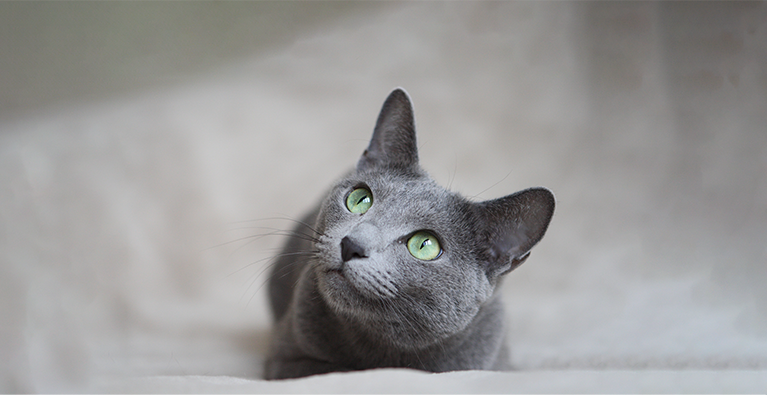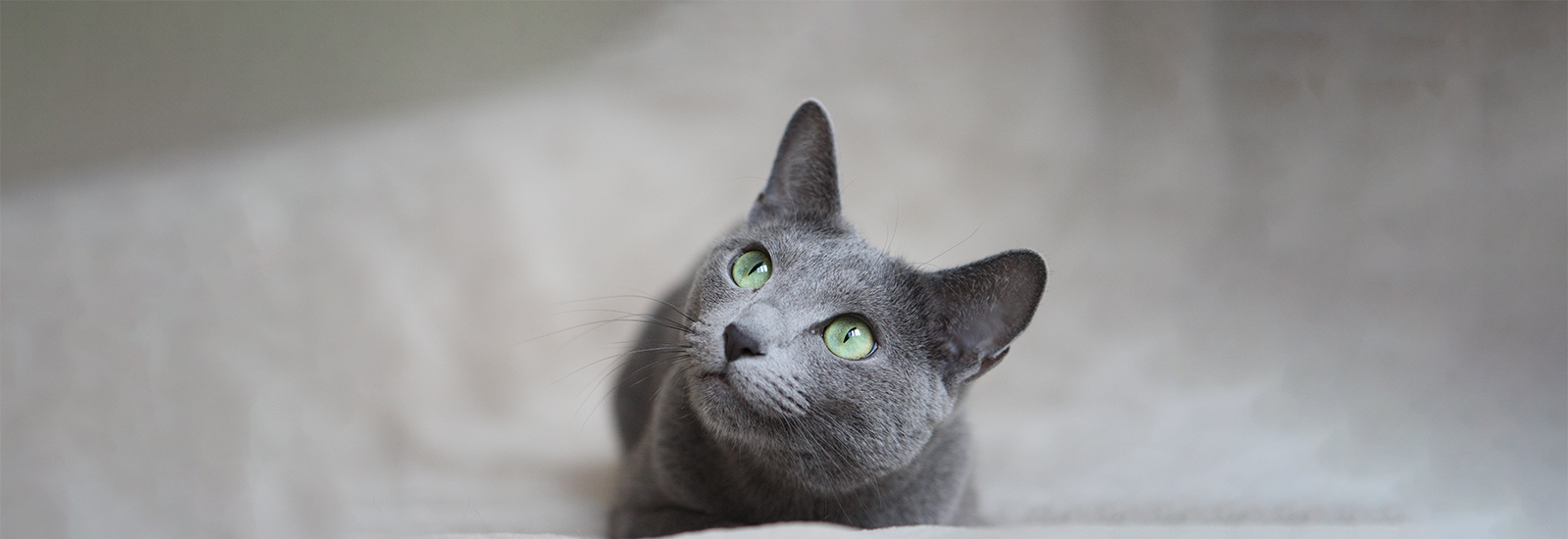Russian Blue
Russian Blue cats are somewhat reserved at first, however as soon as they have gained confidence, they are ready for almost anything: one moment they want to play, then they want a cuddle and after that they simply want to be left alone to sleep.
Profile of the Russian Blue
- Size medium
- Weight female: approx. 3.5 kg, male: approx. 5 kg
- Origin Russia
- Build elongated body, elegant
- Length of fur short
- Colour of fur blue-grey
- Grooming minimal
- Behaviour calm, playful
- Character affectionate, independent
Appearance and character of the Russian Blue
The Russian Blue has a unique appearance, but you have to know how to recognise it. It can easily be mistaken for the blue-grey Carthusian, the Korat and the blue version of the British Shorthair. The British Shorthair, however, has more rounded features and the Korat does not have an undercoat. Only the Russian Blue has a double coat in combination with green eyes. Although its fur is short, it is very dense and fluffy. This is because its undercoat is the same length as its upper coat. As a result, the entire coat stands out slightly from the body. When you stroke a Russian Blue cat, you will realise how soft and silky its fur is. If you look at against the light, you will see a silvery shimmer. This is because the tips of the hairs are colourless, causing the light to be refracted.
The breed standard not only requires a clear silver sheen, but the coat should also be as uniformly blue-grey as possible. A long body, an elegant stature, high legs and a long tapered tail are also desirable. The eyes must be green, the ears not too small and the nose blue-grey. In general, the body should be visibly different from that of an oriental cat and have a stocky, roundish appearance.
The character of the Russian Blue is extremely interesting. At first it appears to be unapproachable, but then you may suddenly find it rubbing up against your visitor’s legs or snuggling down next to them. It just needs a little time. As soon as it starts to trust someone, it turns into an affectionate cat that loves to be cuddled. It is, however, difficult to predict how long this phase will last. All of a sudden, it may decide to go back to its favourite spot on the cat tree or desperately want to play. This highly changeable behaviour is something you must always reckon with. Most people find this fascinating and a lot of fun, but some may prefer a cat that is not quite so unconventional.
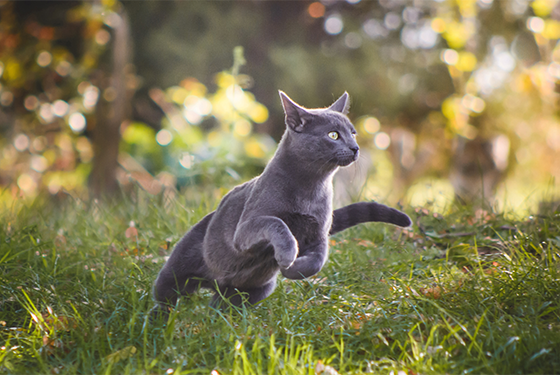
Keeping and caring for a Russian Blue cat
There are no special requirements involved in having a Russian Blue as a pet. It is, however, not without its problems. Sometimes it can get a little moody and will want one thing and then change its mind and want something else. It may even announce this with loud meowing. After a while, you will know exactly what it really wants at any particular moment. Perhaps it is past its usual feeding time, it wants to play with you or it is craving more attention. Although it is important for it to have a place where it can retreat to and not be disturbed, it will not accept any delay when it wants company. It is therefore ideal to have two cats. This prevents a single cat being alone when no one else is at home. A Russian Blue will accept this for a while, but things may become difficult in the long run. If you do just have one cat, you should consider whether it would make sense to let it go outside by means of a cat flap. This is, however, only an option if there is no road traffic nearby. It is also advisable to check with your vet whether any vaccinations or precautions regarding parasites are necessary. In any event, you should make sure that these intelligent creatures are kept occupied in their home, and provide them with plenty of variety in the form of games, cuddly caves and an interesting cat tree.
Because of the Russian Blue’s fluffy coat and undercoat, you could assume that it moults a lot and that you will have to spend a lot of time grooming it. This is, however, not the case. On the contrary: the fur of the Russian Blue is so dense that only minimal amounts of dead hair fall out. The breed is therefore of interest to allergy sufferers. There is, however, no guarantee with any breed of cat. With the Russian Blue, grooming only involves running a comb through its fur once a week. It will then regain its beautiful shine. During the twice-yearly moulting period, grooming should be a little more intense. Most Russian Blue cats do not have a problem with this, and enjoy having your full attention.
Nutrition
Whether it’s a kitten, an adult cat or a senior – the food for a Russian Blue cat should always be of high quality and tailored to its age. Cats are carnivores by nature, so cat food should always contain a high proportion of meaty ingredients. Sugar, flavour enhancers and artificial colourings and preservatives do not belong in the food.
animonda has the ideal food for every stage of your cat’s life. You can choose between kitten, adult and senior cat food. The products are specially formulated to meet the specific nutritional requirements of the different life stages of cats. This provides the best foundation for your pet to enjoy a long and healthy life.
Russian Blue: health
The Russian Blue is a naturally evolved breed of cat. This generally means that the likelihood of hereditary diseases is lower than with breeds that have involved human intervention. It is a very robust, healthy breed of cat. However, the gene pool is somewhat limited. It is therefore important that you buy your pet from a responsible breeder. Here you can rest assured that they regularly have genetic tests carried out and only use healthy cats for breeding. Although there is still a risk, it is significantly lower.
History and breeding
As the name suggests, the Russian Blue has its origins in Russia. It was first documented in the northern harbour town of Arkhangelsk. The winters are icy cold in this region, which explains the breed’s thick, double-layered coat. Sadly, this proved to be their downfall when the Vikings discovered the Russian Blue. They used them to create luxurious fur collars. However, times were not always so cruel for the Russian Blue. On the contrary: from the 18th century onwards, they became increasingly sought-after in noble society. The Russian Tsar Nicholas the First was very fond of the breed and surrounded himself with these cats. He occasionally offered individual specimens as gifts, for example to the Queen of England. Her son, Edward VII, was so enamoured by the Russian Blue that he actually became chairman of a newly founded cat association.
As with many other breeds of cat, the two world wars were a particularly challenging time for the Russian Blue. Breeding programmes sometimes came to a complete standstill. Due to the shortage of suitable animals, the Russian Blue was sometimes crossed with other breeds such as the Siamese, and the British and European Shorthair. As a result, the typical coat of the Russian Blue was increasingly lost. Some breeders then tried to reverse this in a number of different ways, but this led to the creation of different variants. As a result, there are now English, Scandinavian and American varieties of the Russian Blue. It is not advisable to draw strict boundaries here, especially when it comes to ensuring a large gene pool.
The Russian Blue received its first official recognition in 1937 and was recognised by the European governing body, FIFe, in 1949. Although there have been occasional attempts to breed white and black variants for some time now, only blue-grey is currently permitted. The coat should ideally have a medium blue-grey colour with a silver sheen. In addition, the undercoat and upper coat should be of the same length, ensuring its typical fluffy appearance. The difference to other breeds of cat is so obvious that you could recognise a Russian Blue blindfolded.
You may also like this
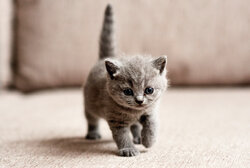
Feeding kitten - nutrition tips
What small kittens need for healthy development
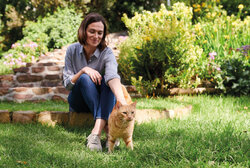
Good cat food
How to recognize good cat food for your darling

A kitten is moving in
Tips for collection, initial equimentd and settling in
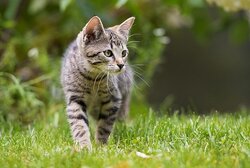
Getting your cat to used to beeing outside
You may also like this
